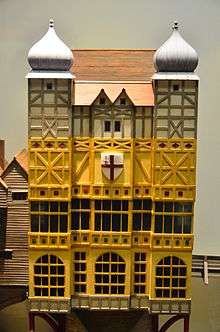Nonsuch House
Nonsuch House was a four-storey house on London Bridge, completed in 1579. It is the earliest documented prefabricated building.[1] Originally constructed in the Netherlands, it was taken apart and shipped to London in pieces in 1578, where it was reassembled, with each timber being marked so that it could be reconstructed correctly. It was assembled in the manner later typical of an American barn or modern prefab housing.[2] The name Nonsuch may have referred to Henry VIII's now vanished Nonsuch Palace outside London; it meant there was "none such" anywhere else, that it was an unequalled paragon of its kind.

All houses on London Bridge were pulled down in 1757.[3]
Description

Nonsuch House was reconstructed on the bridge using joiners' techniques alone, without any carpenter's nails, mason's mortar, or smith's iron. Only wooden pegs were used in the construction.[4] Its archway straddled the bridge. The house was in the centre of the bridge with its principal front facing towards the Southwark end, the principal approach to the city of London from the south. Occupying the place of an entrance to the city, it was elaborately carved with ornate decorations on its east and west Dutch stepped gables, which protruded beyond the sides of the bridge. The house was about twenty-seven feet wide with a floor space in the middle of twenty usable feet.[5]
Nonsuch House had two fronts to the River Thames with large columns, windows, and outside carvings. The square towers at each of its four corners were crowned with onion domes. The gilded vanes on top of these domes could be seen from all parts of the city, as they stood clear above the surrounding structures of the bridge. The house had two sundials on top on the south side. On one of them was painted the adage: Time and tide stay for no man.[5]
Notability
London Bridge, like many large medieval bridges, bore houses and shops along both sides of its length. London Bridge was a great attraction for London, and the Nonsuch House was a notable feature from the sixteenth century until it was torn down in the eighteenth century. Nonsuch House was partially attached to many of the other smaller wooden buildings adjacent on the bridge. The southern front was not connected to any other buildings and it was open for about fifty-six feet in front. The front was ornamented with many transom casement windows.[5]
External links
References
- Anzovin, Steven (2000). Famous First Facts. H. W. Wilson Company. p. 14 item 1191. ISBN 0-8242-0958-3. "The first prefabricated building is considered to be Nonsuch House."
- Picard, Liza (2004). Elizabeth's London. Macmillan. pp. 44–47. ISBN 0-312-32565-7.
- Jesse, John Heneage (1871). London: Its Celebrated Characters and Remarkable Places. R. Bentley. Retrieved 18 December 2018.
- Knight, Charles (1851). London. H. G. Bohn. p. 81.
- "Nonsuch House". Retrieved 2008-09-12.